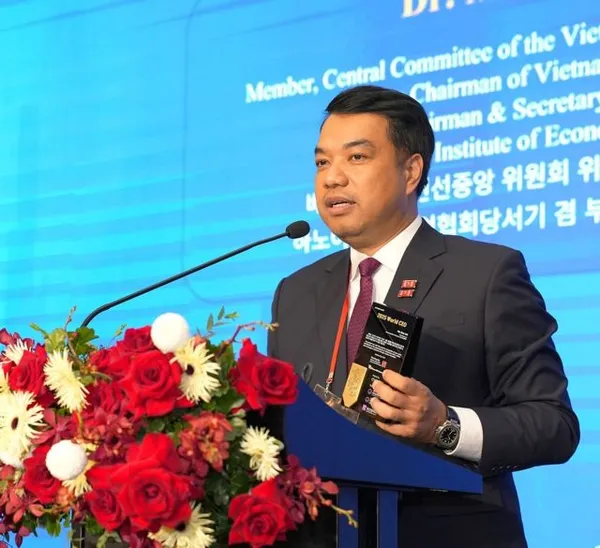 Talking Shop
Talking Shop

 |
| Phạm Tuấn Anh, deputy director of the Department of Industry |
Việt Nam's supporting industry has been active for many years, but so far, it has not met the requirements of manufacturing and assembling companies, especially supplying components for foreign invested enterprises. This is a big obstacle for the stable and sustainable development of the country's economy in the process of deepening integration.
Phạm Tuấn Anh, deputy director of the Department of Industry under the Ministry of Industry and Trade, told the Vietnam News Agency reporter about solutions to promote Việt Nam's supporting industry.
There is a view that Việt Nam's enterprises can only produce fasteners for cars, but they cannot deeply involve in the value chain of the automotive supporting industry. What is your comment on this view and how do you evaluate the current situation of Việt Nam's supporting industry?
I think that this statement is not accurate. This assessment shows that the efforts of businesses as well as ministries and agencies in recent years are not properly appreciated.
In fact, Việt Nam's supporting industry has been brighter although there are still weaknesses.
Specifically, in the automobile manufacturing and assembly industry, Việt Nam's enterprises have actively supplied for 70 per cent of the domestic market for under-seven-seat cars with the localisation rate at more than 50 per cent. They have also met about 90 per cent of the domestic market demand for more-than-10-seat passenger cars with the localisation rate from 20 to 50 per cent.
For some foreign direct investment (FDI) enterprises like Toyota, after 30 years of production and business in Việt Nam, it has built a system of domestic suppliers with 58 enterprises, including 12 Vietnamese enterprises. This number is not commensurate with the potential and expectations but the number should be recognised.
In addition, a number of Toyota's products have also achieved a certain localisation rate, such as the Toyota Innova model with the localisation rate at about 40 per cent, and large export of the electric wire or gearbox product group.
Meanwhile, the localisation rate reaches 40-45 per cent in the textile, leather and footwear industry, 15-20 per cent in the mechanical engineering industry and 5-10 per cent in the electricity and electronics industry.
Therefore, it can be said that enterprises in Việt Nam's supporting industry are able to meet the needs of multinational companies.
Việt Nam has many mechanisms and policies to support the development of the supporting industry, but so far, the industry has not developed as expected. What are reasons for this?
In recent years, the Party and Government have paid special attention to the industrial sector, especially the supporting industry.
Specifically, the Government has issued many legal documents relating to this industry such as Decree 111/2015/NĐ-CP and Resolution 115/NQ-CP in 2020 on promoting the development of the supporting industry.
Other relevant legal documents such as the Investment Law, the Law on Supporting Small and Medium Enterprises and the tax laws, also prescribe policies and conditions to support for the auxiliary enterprises.
However, those enterprises have not developed as expected and neither has their inherent potential.
One of the reasons for this situation is that the policy mechanism is not strong enough, while the resources are not as concentrated as requirements at the Decree 111.
Another obstacle is finance. According to the Ministry of Industry and Trade, Việt Nam's auxiliary enterprises need financial support. In fact, after the ministry reviewed the relevant regulations, it has found that a small number of those enterprises has enjoyed investment incentives.
Along with that, there is not a consistency among ministries and agencies in implementing those policies and regulations.
Localities have still been slow in building development programmes as well as focusing all resources on the supporting industry.
Limitations in capacity of supply, labour, corporate governance, science and technology at the enterprises of this industry are also difficulties.
How is the competitiveness of Việt Nam’s supporting industry compared to foreign ones?
The current capacity of Việt Nam’s firms is behind that of foreign enterprises. A foreign enterprise in Việt Nam receives great support from the parent company abroad.
For example, in terms of finance, the foreign businesses can have loans with low interest rate. Especially, Japanese firms with investment into Việt Nam can get capital with zero interest rate from their parent companies, while Việt Nam’s enterprises must get loans at very high interest rates.
In addition, FDI enterprises entering Việt Nam often bring satellite companies and other enterprises that have been doing business with them to jointly build their own supply system.
It is very difficult for Việt Nam’s businesses to join in their system.
The number of Vietnamese enterprises participating in the multinational corporations' supply chains is very low. What can the Ministry of Industry and Trade do to solve this problem?
Besides the policies of the State and the ministries, it also needs the efforts of businesses. Enterprises must meet criteria set by the corporations in terms of price, delivery time, product quality, and factory scale. There are also environmental and social requirements.
The ministry has been implementing the tasks requested by the Government at the Decree 111 on development of supporting industry, Resolution 115/NQ-CP and Decision 68/QĐ-TTg approving the Supporting Industry Development Programme from 2016 to 2025.
The ministry has regularly coordinated with relevant ministries and agencies in countries that are target markets for Việt Nam's supporting industry such as Japan and South Korea to have cooperation programmes on training and support for businesses.
For example, the Ministry of Industry and Trade of Việt Nam and the Ministry of Industry and Trade of Korea have a cooperation programme on the training of technical staff in the supporting industry. This programme has been implemented very effectively and has changed mindset and the ways to access market of Việt Nam's enterprises.
In the long term, the ministry will perfect the system of legal documents relating to the industrial sector and the supporting industry in particular.
The ministry wishes that the relevant ministries and sectors work together in building synchronous and strong enough policies to support Việt Nam’s auxiliary industry. Thereby, more Việt Nam supporting industry enterprises join to the multinational corporations' supply chains.
What should the domestic enterprises do to participate further in the supply chains?
The businesses must understand their own business, grasping the needs of customers and market trends. Then, they must have plans on developing their products.
They also need to improve ability of the workforce, managers and staff in science and technology fields, and equipment and machinery to gradually meet the multinational corporations' demand.
What should Việt Nam do to strengthen the connection between domestic enterprises and foreign ones in the development of supporting industry?
In the short term, the Ministry of Industry and Trade implements investment promotion activities at home and abroad to find markets for Việt Nam's auxiliary enterprises, and programmes developing suppliers.
For example, the ministry has cooperated with Samsung to effectively implement the programmes on finding suppliers for Samsung. In the near future, the ministry will also have similar programmes with other large corporations in Việt Nam to develop suppliers for them.
In the long term, the ministry will continue to propose the Government programmes and policies to improve efficiency of investment attraction in the supporting industry. That will improve the domestic localisation rate and build supporting industry zones and clusters.
In addition, it is development of services for those zones or clusters to create a complete ecosystem. — VNS




